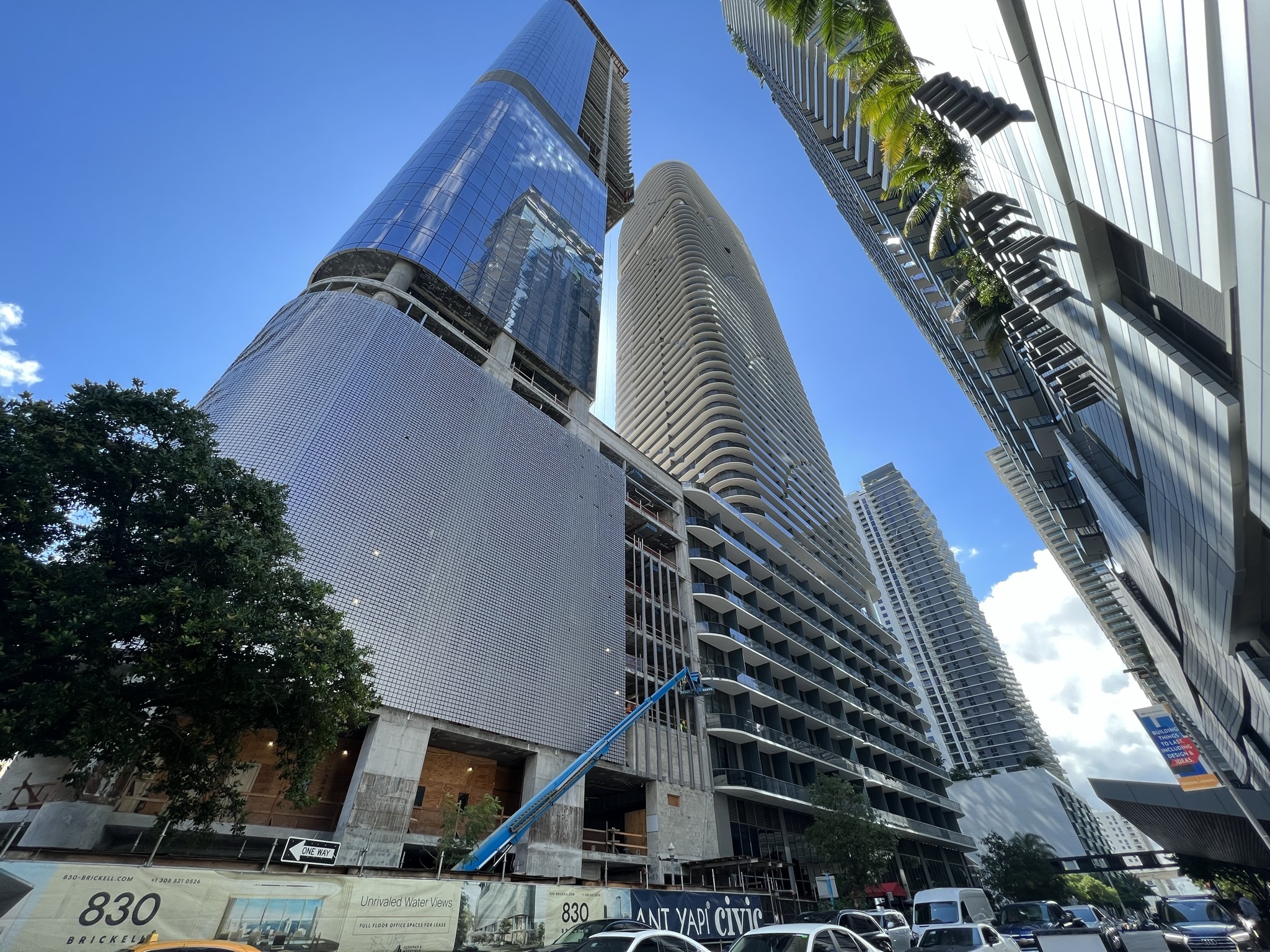WeWork Still Isn’t Profitable, but Miami Has Become Its Paradise
At a WeWork office atop a public parking garage in Miami, dozens of the space’s users, with cups of complementary nitro cold brew or kombucha by their side, occupied a shared lobby and lounge flooded with natural light overlooking the mural-lined streetscape of the Wynwood arts district. Some brought their dogs for the day, sparking impromptu conversation.
On the other side of the 30,000-square-foot floor occupied by WeWork, many private desks and suites were in full use, buzzing with the activity of a more traditional workspace.
The pandemic has roiled the office market and forced many companies to debate whether they allow employees to work partly or entirely remote, but Miami appears to be weathering the shakeout better than other large U.S. cities.
WeWork’s Wynwood location, for instance, is a standout, showing the promise of flexible options. Its workspaces are humming, even after the company last month announced plans to close another 40 underperforming locations as part of an effort to turn a profit after a third-quarter loss of $629 million. And the demand is helping high-profile WeWork weather a downgrade by Fitch Ratings, which said the company’s “significant challenges” may be exacerbated by a global economic slowdown and pandemic-driven hybrid and remote work that has led businesses to rethink their real estate needs.
Miami’s office market has outperformed, thanks to both existing companies and an influx of entrepreneurs and businesses moving to, or expanding in, the region. They have gravitated to well-located, furnished spaces with amenities they can access right away, highlighting the broader flight-to-quality trend. And WeWork is just one of several coworking companies in the city.
“People were looking for a place to work and be productive coming out of COVID,” Nicholas DeMarinis, WeWork’s vice president and head of sales for the Atlantic territory excluding New York, said in an interview. “Miami is one of the first markets to have that kind of a return. Every company is looking for flexibility whether they need a dedicated office or someplace in between work and home for the day.”
The Wynwood location, which WeWork opened in August 2019, is one of its six in Miami since the New York-based company entered the market in 2015. It’s 100% occupied, according to DeMarinis.
WeWork’s Miami offices combined posted a 97% physical occupancy in the second quarter, WeWork’s highest occupied market globally. WeWork declined to give third-quarter specifics, but a spokesperson said the coastal city, the second-most populated in Florida, remains the firm’s most occupied market. WeWork had 801 owned and franchised locations across 39 countries as of Sept. 30.
The market also is a top performer when it comes to on-demand bookings, DeMarinis said. Year to date through August, hourly or daily users more than quadrupled from a year earlier, he said, while all-access bookings, which give members access to locations around the world, rose 75%.
The city has been a “great landing spot” with a “heavy influx of new-to-market tenants,” said DeMarinis, who oversees 11 cities including Montreal, Boston, Philadelphia, Atlanta and the Tennessee capital of Nashville. “Our success is a success of the environment.”
In Miami, WeWork has attracted a two-person startup, small and medium-size firms, Fortune 100 companies and “some of the largest hedge funds of the world,” DeMarinis said, adding all six locations have a waitlist.
Members’ industries run the gamut, including cryptocurrency, financial services, law firms, technology and real estate. Latin American businesses are part of the mix too, with Miami being a gateway to countries south of Florida.
Nir Ashkenazi, a California native and chief executive and co-founder of startup Groomer.io, a software provider to pet grooming businesses, is one of the newcomers.
He set up shop in a WeWork office in Brickell, Miami’s financial district, several miles south of Wynwood.
His arrival came by chance. He visited the city on a vacation with his former fiancée in the summer of 2021. “I saw how busy Brickell was, and I told her, ‘I want to stay in Miami. … California is dead,’” he said in an interview.
It helped that WeWork was on the scene. After the pandemic sent U.S. office workers home in March 2020, Groomer.io, founded in 2015 in a Los Angeles suburb, ended its traditional office lease. After three months of working at home, Ashkenazi said he was “losing [his] mind.” He got an office at a Los Angeles WeWork and began to travel and work out of different WeWorks, including Colombia in South America and in Brickell, where he saw how busy the Miami location was versus California because of Florida’s less restrictive COVID policies.
“The fact that I can go around the world to different WeWorks is amazing. I interact with people. I met great people at WeWork and got connections that way,” Ashkenazi said.
His office is at the WeWork in the Brickell City Centre, a $1 billion, 4.9 million-square-foot, mixed-use complex that’s packed with luxury shops, restaurants and entertainment options.
“You could just go downstairs, go shopping, get food and just be close to everything,” he said.
Back at WeWork’s Wynwood location, Giovana Driessen, CEO of Elephant Skin, which produces 3D renderings and other marketing materials for real estate projects, has secured a private office for 10.

Elephant Skin has embraced remote work since it was founded in 2017. It gave its 125-person global team WeWork’s all-access memberships, which were introduced in 2020.
“My Wi-Fi is already on because [WeWork locations] have all the same password,” she said. “I can taste the same coffee anywhere. … I like the sparkling water from the tap. I know that I will have my phone booth when I have a meeting. It’s just very convenient. … Local clients respect us more because we have a place that they can go to. We can be more local, even if we are not from there.”
The other companies seeking to capitalize on strong demand for flexible office space in Miami include rival Industrious. The firm, which counts brokerage giant CBRE as its lead minority investor, recently opened its second Miami location in South Beach after entering the market in March 2020 in Brickell. Industrious plans to open a location in Wynwood this month.
Industrious’ Miami locations run on management agreements with landlords as part of a growing industrywide trend to lessen leasing risks. “Landlords are very excited about flex,” said Peri Demestihas, senior director of real estate at Industrious, in an email.
Demestihas said Industrious has “multiple new locations coming to market” including in nearby Aventura and West Palm Beach. “Miami is an extremely strong market and consistently is one of our top performers nationwide.”
“Miami is definitely one of our top priority markets in terms of growth,” he said.
IWG, billed as the world’s largest flexible space provider, recently said it plans to open six new locations in Florida, including a Spaces in the Miami suburb of Coral Gables and a Regus in Miami.
The company is expanding in Florida and South Florida “to meet the demand for hybrid work in one of the fastest-growing coworking markets” in the United States, a spokesperson told CoStar News. IWG already had over 76 locations in Florida, including 23 in the Miami area.
Newmark-owned Knotel is also said to be expanding in Miami among other flexible space providers.
The competitive coworking landscape poses a challenge for WeWork as it seeks to become profitable. After growing for almost a decade, WeWork had to scrap its first attempt at an initial public offering in 2019 amid investor concerns about corporate governance. That led to the ouster of co-founder and former CEO Adam Neumann, who was the subject of a limited Apple TV+ series, and subsequent management worked on reducing costs as they led the company to go public through the use of a special-purpose acquisition company, or SPAC, last year.
According to brokerage firm Savills, South Florida had a second-quarter flexible office vacancy rate of 2.9%, lower than that of many cities including Los Angeles, Atlanta, Chicago, Boston, D.C. and Dallas.
Miami’s second-quarter flexible office cumulative rent growth rose 7.5% from a year earlier, above that of other top performers including nearby Palm Beach as well as Las Vegas in Nevada and the Inland Empire in California, Savills said.
“Most major coworking operators are targeting Miami for expansions,” Ben Wright, head of flexible office solutions for the brokerage firm SquareFoot, said in an email. “Miami was one of the earliest markets in North America to recover after COVID. Miami has seen a number of new coworking openings from companies like Industrious, Quest Workspaces, and will see many more.”
Demand for small offices looks to be especially strong. Rates for one- or two-person private offices in 93 locations in Miami have posted sharp gains and outpaced the U.S. average, data from SquareFoot unit Upsuite shows.
For instance, at the start of COVID in the second quarter of 2020, the average price for a one- or two-person private suite in Miami was $642.42, trailing the U.S. average of $800.56. By the third quarter of this year, Miami’s rate has gone up to $857.59, outpacing the U.S. average of just shy of $800, the data shows.
Miami’s flexible market growth has been helped by the nature of the city’s Class A office market, Andrew Trench, executive director of Cushman & Wakefield’s Miami-based leasing team, said in an interview.
Pre-COVID, Miami’s office market had little new top-quality supply, and leasing transactions often involved existing firms relocating to, say, newer developments without much out-of-town activity, according to Trench. During the pandemic, with major names including investment firms Apollo Global Management and Citadel moving in, the equation changed, he said.
With “this dynamic of all these people now wanting to open offices down here … they wanted to be in the nicest office space imaginable, because this wasn’t some call center moving here,” Trench, who was born and raised in Miami, told CoStar News. “They said, ‘All right, if I’m coming to Miami, I’m going to look at the ocean every day. I’m going to be in the nicest office space possible.’ What they found was, we didn’t have a lot of that. We haven’t been able to build new office buildings that much over the last 20 years.”

Flexible space providers found they could fill the gap.
The companies coming in “needed to go somewhere in the meantime,” Trench said. “They wanted to be in a nice building. That’s where we’ve seen a lot of our coworking and flex spaces fill up. It’s generally used as swing space or temporary space for companies who are waiting for their ultimate long-term space to be completed. Either that, or they’re still experimenting with Miami.”
For example, private equity firm Thoma Bravo, with offices in San Francisco and Chicago, has interim space at WeWork’s Wynwood location while it awaits completion of the 1 million-square-foot 830 Brickell, where Cushman is the exclusive leasing agent, Trench said. Described as the area’s first “Class A+ freestanding office building to be built in over a decade,” 830 Brickell also has signed hedge fund giant Citadel and law firm Sidley Austin, according to brokerage firms’ market reports.
For Citadel, 830 Brickell is itself said to be a temporary home as the Chicago firm founded by billionaire investor Ken Griffin is building its headquarters, in partnership with developer Sterling Bay, nearby at 1201 Brickell Bay Drive.
“We’re seeing more new offices develop now than we’ve ever had in my career or the history of Miami,” Trench said. “Developers want a piece of the action.”
For example, L&L Holding, which recently completed 425 Park Ave., the first full-block office tower on Manhattan’s headquarters-heavy corridor in decades, is planning a 1 million-square-foot, mixed-use apartment, office and retail project in Wynwood, its first major development in Miami.
“There’s a real growth in the Sun Belt states, and Florida in particular is off-the-charts good,” New York-based L&L President and Chief Investment Officer Robert Lapidus said in an interview, adding he himself has spent the past three winters in the area since the pandemic began. “It’s a great place to have some long-term investment. There aren’t really very many good office buildings in Florida. Most of the high-end developments have been residential condos. … We could [be] creating amenitized, awesome office buildings as part of mixed-use developments and creating an ecosystem. … That whole live-work-play experience in one place.”
Between 2020 and 2021, Miami-Dade County’s economic development organization said in a study that it helped 30 major companies relocate to or expand in Miami from cities including New York, Detroit and the San Francisco Bay Area. In 2021, new job commitments and average wages rose to the highest level in the group’s 36-year history.
New York-based investment giant Blackstone Group relocated its technology office to Miami’s central business district, joining others including Japan’s SoftBank in the move south, the organization said.
Miami’s growth doesn’t come without challenges. Its traffic and lack of extensive public transit and other infrastructure are among common complaints that highlight its limits in meeting the demands of an inbound wave of office workers.
“We’re at a point now where the traffic’s really bad pretty much everywhere,” Trench said.
As top-tier office demand tops supply, tenants are willing to pay up.
For instance, the past few leases at 830 Brickell have been about $130 per square foot, doubling what Cushman had estimated the building would lure when it got the listing four years ago, Trench said. He added that the average for the entire building is north of $100 per square foot and expects it to be fully leased by the time it’s completed.

That’s drastically different from in the past, when Miami’s office leasing traditionally was about “stealing tenants from other buildings” without much of a price bump and developers building on speculation without tenants lined up, he said.
“I don’t think any city has ever seen that fast of a rise in rental rates,” Trench said. “The companies who are moving here are used to paying close to $200 a square foot in Manhattan. … They’ll pay what they need to get what they want. Miami hadn’t had that dynamic before.”
To see how the shortage of top-tier offices in desirable locations in Miami is spurring development, just take a look at what’s touted as the first new Class A building in Miami’s Design District.
The Ursa, a 15-story development located at 30 N.E. 39th St., is led by Miami Design District Associates, the group behind the tony shopping district and a partnership between entrepreneur Craig Robins’ Dacra; global luxury powerhouse LVMH-tied L Catterton Real Estate; and Brookfield Properties. Designed by famed global architectural and design firms Arquitectonica and Arsham Studio and featuring floor plates from 18,600 to 21,400 rentable square feet, the building, which will feature private outdoor balconies on each floor and amenities such as conference rooms with 360 degree views, is expected to be completed in the fall of 2024, according to its website.
It’s just one example that shows how Florida is expected to fare better against concerns about a potential recession, higher interest rates and inflation that have seized up lending and other business activities in the country.
“Businesses are going to be affected … whether it’s in Florida, New York, Chicago or Texas,” Steven Sperandio, Ripco Real Estate’s executive managing director and co-head of debt and structured finance, said in an interview. “Florida is going to fare just a little bit better than the average because there are so many people who have moved and still continue to move here. … [Lenders] told us on a number of occasions that they’re very excited and positive and bullish about opportunities in Florida.”
Nearly 260,000 people moved to Florida in the 12 months through July 2021, with the Sunshine State leading the nation with over 700 people moving in per day, according to a Tampa Bay Economic Development Council study, citing census data. The report found California and New York led the country with over 900 people moving out a day during the same time.
Sperandio, a longtime New York resident before moving his family to the Miami area during the pandemic, said Florida has become a growing part of his financing deals across property types, which traditionally were primarily New York-area projects.
“There’s still plenty of deals in New York,” he said, adding he flies between New York and Miami regularly. “But there’s just a lot of activity in Florida. … Every Florida deal is a new deal.”
What’s driving people and businesses to move to Miami and Florida aren’t just the weather, lack of state or local income tax or lower corporate taxes compared to New York or California.
In the early phase of COVID, “a lot of really wealthy people from very dense cities like Manhattan came down here to ride out the storm, thinking, ‘This COVID thing will be a few weeks, maybe a few months,’” Trench said. “Obviously COVID lasted way longer than that. They ended up being down here much longer than they thought. … It was this forced experiment on them, and they realized it’s pretty nice living down here actually.”
That changed the thinking of people who didn’t take moving to Miami seriously pre-pandemic, he said.
“What happened first was a quality-of-life prioritization,” he said. “Very high-level people, like top hedge fund managers out of New York or CEOs and principals of companies … they realized, ‘I really like this here. I can live on the water and have nice tree-lined suburban neighborhood like Coconut Grove and be 10 minutes from my office in Brickell, whereas maybe in New York, I’m either living in a condo in a very dense building or I had to take a 45-minute train from Long Island or Greenwich.’”

Flexible workplace growth has spread beyond Miami. A Savills global study released in July found the pandemic has changed work patterns worldwide, with 78% of respondents saying they used flexible offices three to four times a week. Companies with more than 101 employees and those with employees between 21 and 101 together represented 42% of global flexible office occupiers, up from 37% last year.
“We’re seeing momentum in other markets as well,” WeWork’s DeMarinis said, pointing to examples including Nashville and Toronto. “Miami has just led the way. … Employers are increasingly looking at where their talent is, where they are living, where they want to work. That’s how they’re pivoting the way they’re making decisions.”



